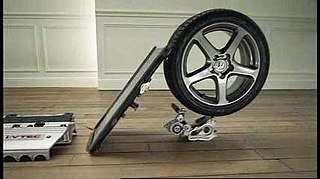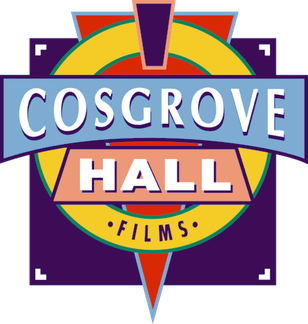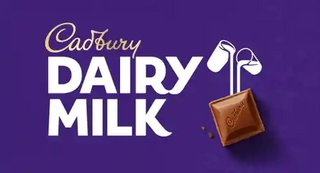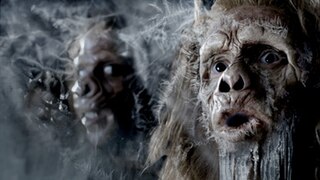
Stop motion is an animated filmmaking technique in which objects are physically manipulated in small increments between individually photographed frames so that they will appear to exhibit independent motion or change when the series of frames is played back. Any kind of object can thus be animated, but puppets with movable joints or plasticine figures are most commonly used. Puppets, models or clay figures built around an armature are used in model animation. Stop motion with live actors is often referred to as pixilation. Stop motion of flat materials such as paper, fabrics or photographs is usually called cutout animation.

A television advertisement is a span of television programming produced and paid for by an organization. It conveys a message promoting, and aiming to market, a product, service or idea. Advertisers and marketers may refer to television commercials as TVCs.

Creature Comforts is a British adult stop-motion comedy mockumentary franchise originating in a 1989 British humorous animated short film of the same name. The film matched animated zoo animals with a soundtrack of people talking about their homes, making it appear as if the animals were being interviewed about their living conditions. It was created by Nick Park and Aardman Animations. The film later became the basis of a series of television advertisements for the electricity boards in the United Kingdom, and in 2003, a television series in the same style was released. An American version of the series was also made. A sequel series, Things We Love, first aired on BBC One in 2024.

"Cog" is a British television and cinema advertisement launched by Honda in 2003 to promote the seventh-generation Accord line of cars. It follows the convention of a Rube Goldberg machine, utilizing a chain of colliding parts taken from a disassembled Accord. Wieden+Kennedy developed a £6 million marketing campaign around "Cog" and its partner pieces, "Sense" and "Everyday", broadcast later in the year. The piece itself was produced on a budget of £1 million by Partizan Midi-Minuit. Antoine Bardou-Jacquet directed the seven-month production, contracting The Mill to handle post-production. The 120-second final cut of "Cog" was broadcast on British television on 6 April 2003, during a commercial break in ITV's coverage of the 2003 Brazilian Grand Prix.

Cosgrove Hall Films was a British animation studio founded by Brian Cosgrove and Mark Hall, headquartered in Chorlton-cum-Hardy, Manchester. Cosgrove Hall was a major producer of children's television and animated programmes/films, which are still seen in over eighty countries. The company was wound down by its then owner, ITV plc, on 26 October 2009. It was mainly known for its series Danger Mouse, The Wind in the Willows and Count Duckula.

M&M's are color-varied sugar-coated dragée chocolate confectionery, each of which has the letter "m" printed in lower case in white on one side, consisting of a candy shell surrounding a filling which varies depending upon the variety of M&M's. The original candy has a semi-sweet chocolate filling which, upon introduction of other variations, was branded as the "plain, normal" variety. Peanut M&M's, which feature a peanut coated in milk chocolate, and finally a candy shell, were the first variation to be introduced, and they remain a regular variety. Numerous other variations have been introduced, some of which are regular widespread varieties while others are limited in duration or geographic availability. M&M's are the flagship product of the Mars Wrigley Confectionery division of Mars, Incorporated.

Rankin/Bass Animated Entertainment was an American production company located in New York City, and known for its seasonal television specials, usually done in stop motion animation. Rankin/Bass's stop-motion productions are recognizable by their visual style of doll-like characters with spheroid body parts and ubiquitous powdery snow using an animation technique called Animagic.

Cadbury Dairy Milk is a British brand of milk chocolate manufactured by Cadbury. It was introduced in the United Kingdom in June 1905 and now consists of a number of products. Every product in the Dairy Milk line is made with exclusively milk chocolate. In 1928, Cadbury's introduced the "glass and a half" slogan to accompany the Dairy Milk chocolate bar, to advertise the bar's higher milk content.

Poppin' Fresh, more widely known as the Pillsbury Doughboy, is an advertising mascot for the Pillsbury Company, appearing in many of their commercials. Many commercials from 1965 until 2005 ended with a human finger poking the Doughboy's belly. The Doughboy responds by giggling when his belly is poked.

Rudolph the Red-Nosed Reindeer is a 1964 stop motion Christmas animated television special produced by Videocraft International, Ltd. and currently distributed by NBCUniversal Television Distribution. It first aired December 6, 1964, on the NBC television network in the United States and was sponsored by General Electric under the umbrella title of The General Electric Fantasy Hour. The special was based on the 1949 Johnny Marks song "Rudolph the Red-Nosed Reindeer" which was itself based on the poem of the same name written in 1939 by Marks's brother-in-law, Robert L. May. Since 1972, the special has aired on CBS. The network unveiled a high-definition, digitally remastered version of the program in 2005, re-scanned frame-by-frame from the original 35 mm film elements.

Hershey's Kisses is a brand of chocolate first produced by the Hershey Company in 1907. The bite-sized pieces of chocolate have a distinctive conical shape, sometimes described as flat-bottomed teardrops. Hershey's Kisses chocolates are wrapped in squares of lightweight aluminum foil. A narrow strip of paper, called a plume, sticks out from the top of each Hershey's Kiss wrapper. Originally designed as a flag for the "Hershey's" brand, the printed paper plumes were added to the Kisses product wrapper in 1921 to distinguish the Hershey's Kiss from its competitors who were offering similar products.

Reese's Peanut Butter Cups are an American candy by the Hershey Company consisting of a peanut butter filling encased in chocolate. They were created on November 15, 1928, by H. B. Reese, a former dairy farmer and shipping foreman for Milton S. Hershey. Reese was let go from his job with Hershey when the Round Barn which he managed was shut down for cost-saving measures. He subsequently decided to start his own candy business. Reese's are a top-selling candy brand worldwide, with more than $2 billion in annual sales.

Crazy Frog is a Swedish CGI-animated character and Eurodance musician created in 2003 by actor and playwright Erik Wernquist. Marketed by the ringtone provider Jamba!, the character was originally created to accompany a sound effect produced by Daniel Malmedahl while attempting to imitate the sound of a two-stroke engine.

La Une is a Belgian national television channel, owned and operated by the French-language public-service broadcasting organization RTBF. La Une is the equivalent of Flemish station VRT 1, of the Flemish broadcaster VRT.

noitulovE is a British television and cinema advertisement launched by Diageo in 2005 to promote Guinness Draught stout. The 60-second piece formed the cornerstone of a £15 million advertising campaign targeting men in their late twenties and early thirties. The commercial shows, in reverse, the adventures of three characters who evolve from mudskippers to present day humans before tasting Guinness in a London pub. The commercial was handled by the advertising agency Abbott Mead Vickers BBDO, with a budget of £1.3M. It was directed by Daniel Kleinman. Production was contracted to Kleinman Productions, with post-production by Framestore CFC. It premiered on British television on 3 October 2005.
United Kingdom Animation began at the very origins of the art form in the late 19th century. British animation has been strengthened by an influx of émigrés to the UK; renowned animators such as Lotte Reiniger (Germany), John Halas (Hungary), George Dunning and Richard Williams (Canada), Terry Gilliam and Tim Burton have all worked in the UK at various stages of their careers. Notable full-length animated features to be produced in the UK include Animal Farm (1954), Yellow Submarine (1968), Watership Down (1978), and Wallace & Gromit: The Curse of the Were-Rabbit (2005).
BENT IMAGE LAB is a production company and animation studio specializing in story development, television, commercials, visual effects, music videos, short films, experimental techniques and tech development in augmented reality (AR). Located in Portland, Oregon, the company was founded in 2002 by partners David Daniels, Ray Di Carlo, and Chel White.
Mountain is a 2003 television and cinema advertisement launched by Sony Corporation to promote the PlayStation 2 video game console. The budget for production and advertising space purchases for the 60-second piece amounted to £5m across all markets. The commercial depicts a Brazilian crowd congregating to form a mountain of human bodies, all competing to reach the top of the pile. The campaign surrounding Mountain was handled by advertising agency TBWA London. The commercial was directed by Frank Budgen. Production was contracted to Gorgeous Enterprises, with post-production by The Mill. Mountain premiered in 30 countries on 13 November 2003.

Computer-generated imagery (CGI) is a specific-technology or application of computer graphics for creating or improving images in art, printed media, simulators, videos and video games. These images are either static or dynamic. CGI both refers to 2D computer graphics and 3D computer graphics with the purpose of designing characters, virtual worlds, or scenes and special effects. The application of CGI for creating/improving animations is called computer animation, or CGI animation.

The Japanese technology company, Sony, engaged in a variety of different marketing efforts, as one of the world's largest and most pervasive corporations.

















